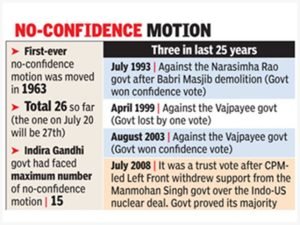Prelims – 5th Nov 23
Rights of Persons with Disabilities Act, 2016
- It came into force to give effect to the United Nations Convention on the Rights of Persons with Disabilities (UNCRPD).
- The Act has categorized person with disability into three:
- Person with benchmark disability;
- Person with disability;
- People with disabilities having high support needs.
- The Act increases type of disability from 7 to 21 types and the Central Government has the power to add more to the list.
- These 21 types of disabilities include: Blindness, Low-vision, Leprosy Cured persons, Hearing Impairment (deaf and hard of hearing), Locomotor Disability, Dwarfism, Intellectual Disability, Mental Illness, etc.
- The Act has increased the quantum of reservation for people suffering from disabilities from 3% to 4% in government jobs and from 3% to 5% in higher education institutes.
- Every child with benchmark disability between the age group of 6 and 18 years shall have the right to free education.
- A separate National and State Fund be created to provide financial support to the persons with disabilities.
No-Confidence Motion
- In a parliamentary democracy, a government can be in power only if it commands a majority in the directly elected House.
- Article 75(3) of the Indian Constitution embodies this rule by specifying that the Council of Ministers are collectively responsible to the Lok Sabha.

- For testing this collective responsibility, the rules of Lok Sabha provide a particular mechanism – a motion of no-confidence.
- The procedure is specified under Rule 198 of the Lok Sabha.
- The Constitution does not mention either a Confidence or a No Confidence Motion.
- Any Lok Sabha MP, who can garner the support of 50 colleagues, can, at any point of time, introduce a motion of no-confidence against the Council of Ministers.
- A no-confidence motion can be moved only in the Lok Sabha. It cannot be moved in the Rajya Sabha.
Extended Producer Responsibility (EPR)
-
- OECD definesEPR as an environmental policy approach in which a producer’s responsibility for a product is extended to the post-consumer stage of a product’s life cycle.
- An EPR policy is characterised by
- The shifting of responsibility (physically and/or economically; fully or partially) upstream toward the producer and away from municipalities
- The provision of incentives to producers to take into account environmental considerations when designing their products.
- Under India’s G-20 presidency, there is an emphasis on the significance of the EPR framework in integrating circularity throughout the value chain.
- As different countries have implemented different EPR models, it is necessary that G-20 member-countries share best practices to accelerate the transition to a circular economy.
- Effective implementation of EPR plays a pivotal role in promoting the growth of the recycling infrastructure and establishing a streamlined waste collection system.
- With over 20,000 registered Producers, Importers, and Brand Owners (PIBOs) and over 1,900 plastic waste processors on the centralised EPR portal, India boasts one of the largest frameworks for EPR.
- The combined EPR obligation of registered PIBOs crosses 3.07 million tons.
- India has also notified comprehensive rules for e-waste and battery waste management.
